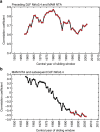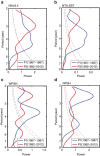Enhanced biennial variability in the Pacific due to Atlantic capacitor effect
- PMID: 28317857
- PMCID: PMC5364382
- DOI: 10.1038/ncomms14887
Enhanced biennial variability in the Pacific due to Atlantic capacitor effect
Abstract
The El Niño-Southern Oscillation (ENSO) and the variability in the Pacific subtropical highs (PSHs) have major impacts on social and ecological systems. Here we present an Atlantic capacitor effect mechanism to suggest that the Atlantic is a key pacemaker of the biennial variability in the Pacific including that in ENSO and the PSHs during recent decades. The 'charging' (that is, ENSO imprinting the North Tropical Atlantic (NTA) sea surface temperature (SST) via an atmospheric bridge mechanism) and 'discharging' (that is, the NTA SST triggering the following ENSO via a subtropical teleconnection mechanism) processes alternate, generating the biennial rhythmic changes in the Pacific. Since the early 1990s, a warmer Atlantic due to the positive phase of Atlantic multidecadal oscillation and global warming trend has provided more favourable background state for the Atlantic capacitor effect, giving rise to enhanced biennial variability in the Pacific that may increase the occurrence frequency of severe natural hazard events.
Conflict of interest statement
The authors declare no competing financial interests.
Figures





Similar articles
-
North Atlantic oscillation controls multidecadal changes in the North Tropical Atlantic-Pacific connection.Nat Commun. 2023 Feb 16;14(1):862. doi: 10.1038/s41467-023-36564-3. Nat Commun. 2023. PMID: 36792593 Free PMC article.
-
Western tropical Pacific multidecadal variability forced by the Atlantic multidecadal oscillation.Nat Commun. 2017 Jul 7;8:15998. doi: 10.1038/ncomms15998. Nat Commun. 2017. PMID: 28685765 Free PMC article.
-
Greenhouse warming intensifies north tropical Atlantic climate variability.Sci Adv. 2021 Aug 25;7(35):eabg9690. doi: 10.1126/sciadv.abg9690. Print 2021 Aug. Sci Adv. 2021. PMID: 34433566 Free PMC article.
-
Sea surface temperature variability: patterns and mechanisms.Ann Rev Mar Sci. 2010;2:115-43. doi: 10.1146/annurev-marine-120408-151453. Ann Rev Mar Sci. 2010. PMID: 21141660 Review.
-
Pantropical climate interactions.Science. 2019 Mar 1;363(6430):eaav4236. doi: 10.1126/science.aav4236. Science. 2019. PMID: 30819937 Review.
Cited by
-
Enhanced joint impact of western hemispheric precursors increases extreme El Niño frequency under greenhouse warming.Nat Commun. 2023 Oct 11;14(1):6356. doi: 10.1038/s41467-023-42115-7. Nat Commun. 2023. PMID: 37821430 Free PMC article.
-
Effects of El Niño on summertime ozone air quality in the eastern United States.Geophys Res Lett. 2017 Dec 28;44(24):12543-12550. doi: 10.1002/2017GL076150. Epub 2017 Dec 13. Geophys Res Lett. 2017. PMID: 29622852 Free PMC article.
-
Stronger and prolonged El Niño-Southern Oscillation in the Early Eocene warmth.Nat Commun. 2025 Apr 30;16(1):4053. doi: 10.1038/s41467-025-59263-7. Nat Commun. 2025. PMID: 40307213 Free PMC article.
-
Spurious North Tropical Atlantic precursors to El Niño.Nat Commun. 2021 May 25;12(1):3096. doi: 10.1038/s41467-021-23411-6. Nat Commun. 2021. PMID: 34035285 Free PMC article.
-
Seasonally-reversed trends in the subtropical Northwestern Pacific linked to asymmetric AMO influences.Sci Rep. 2023 Aug 23;13(1):13735. doi: 10.1038/s41598-023-40979-9. Sci Rep. 2023. PMID: 37612406 Free PMC article.
References
-
- Dai A., Trenberth K. E. & Karl T. R. Global variations in droughts and wet spells: 1990–1995. Geophys. Res. Lett. 25, 3367–3370 (1998).
-
- Barnard P. L. et al.. Coastal vulnerability across the Pacific dominated by El Niño/Southern Oscillation. Nat. Geosci. 8, 801–807 (2015).
-
- Rasmusson E. M., Wang X. & Ropelewski C. F. The biennial component of ENSO variability. J. Mar. Syst. 1, 71–96 (1990).
-
- Barnett T. P. The interaction of multiple time scales in the tropical climate system. J. Clim. 4, 269–285 (1991).
Publication types
LinkOut - more resources
Full Text Sources
Other Literature Sources

